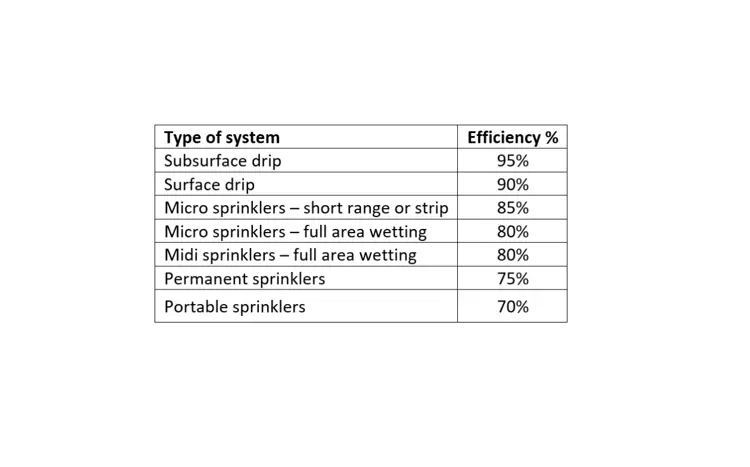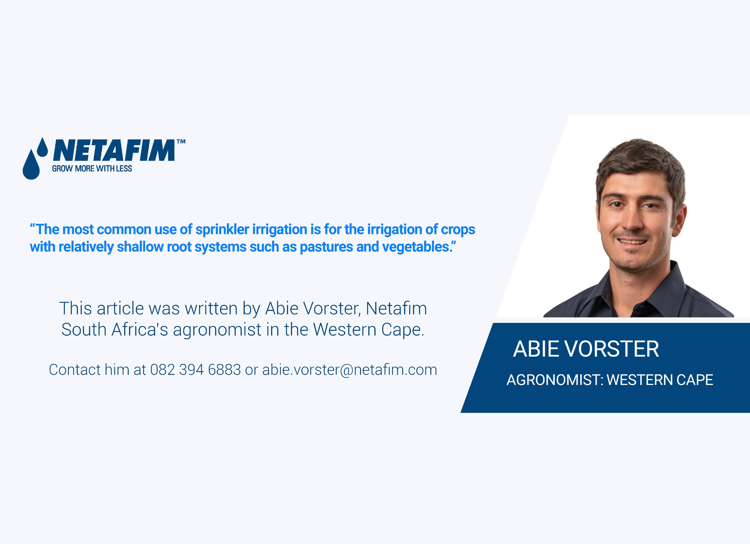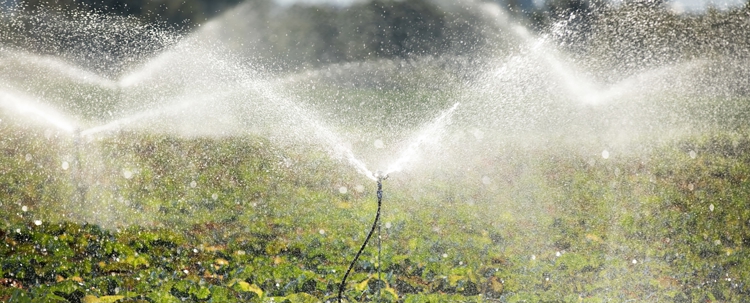Open-field sprinkler irrigation: What you need to know
This article focuses on irrigation with midi and macro/impact sprinklers and where these sprinklers fit into the irrigation puzzle. (We will refer to midi and macro/impact sprinkler irrigation as ‘sprinkler irrigation’ for the purpose of this article)
Water use efficiency must always be the main focus of any irrigation system. To ensure optimal water use efficiency, the choice of irrigation system is extremely important with consideration to the crop, conditions, and circumstances.
Sprinkler irrigation can often be perceived as ineffective in terms of water use efficiency and wasteful if compared to drip irrigation. The fact is that certain irrigation technologies have a higher level of efficiency compared to others (see Table 1. System Efficiency Guidelines). This however does not mean that the system is inefficient. Any irrigation system that is designed correctly according to the hydraulic specifications can achieve a high degree of water use efficiency.
An informed decision can therefore only be made by comparing all suitable types of irrigation for your circumstances. The purpose of this article is to inform you about the basics of sprinkler irrigation to help you determine if it is the right fit for your project.

Sprinkler specifics
Sprinkler irrigation wets the full area of irrigation and is known as full-surface irrigation. This is compared to micro-sprinkler and drip irrigation that wets a certain percentage of the area and are described as localised irrigation. The most common use of sprinkler irrigation is for the irrigation of crops with relatively shallow root systems such as pastures and vegetables.
In the case of vegetables or other crops grown from seeds, sprinkler irrigation is generally the preferred irrigation method due to its efficiency in seed germination. However, after germination the need for full-surface irrigation becomes less relevant and a lot of water can be saved by irrigating only the root zone of each plant.
Superior service
As with any irrigation system, there are many factors to consider when designing a sprinkler irrigation system and selecting a suitable sprinkler. This includes factors such as the crop, soil types, topography, total area to be irrigated, water quality and availability, energy requirement and availability, and sprinkler properties. A very important factor not to forget when selecting a product and supplier, is the support service offered by the product dealer and/or manufacturer.
Generally, the most suitable circumstances for sprinkler irrigation would entail soil with a relatively high infiltration rate, even topography, a crop with a shallow root system, low wind occurrence and sufficient water availability.
Pros and cons
Sprinkler irrigation has high application rates, which makes it a very effective way to transfer a lot of water in a relatively short time. Especially if you have limited storage capacity and are dependent on scheme irrigation water with regulated irrigation times.
Another advantage of sprinkler irrigation, is that it requires a lower level of filtration, compared to micro-sprinkler and drip irrigation. This lowers the initial capital expenditure on filtration equipment.
Sprinkler irrigation further allows flexibility, as it can be designed and installed as a permanent, semi-permanent or even portable irrigation system.
The greatest threat to the efficiency of sprinkler irrigation is high windspeeds. Windspeeds higher than 16km/h can increase evaporation and negatively affect water distribution. Other disadvantages include the high volume of water required in comparison to localised irrigation systems, the risk of insects blocking sprinkler nozzles that effects water distribution and increase the need for maintenance, as well as the fact that UV rays damage the plastic and can eventually influence the sprinklers’ efficiency.
Sprinkler blunders
The selection of the irrigation method and product is only one aspect of successful irrigation. The success of a system greatly depends on the design, installation and scheduling. The most common mistake made in sprinkler irrigation design, is incorrect system pressure. If the system pressure is too high, evaporation will increase, and a large percentage of the water that is irrigated will never reach the soil surface. While a too low or high system pressure will result in poor water distribution, negatively impacting crop uniformity and yield.
To design and install an efficient sprinkler irrigation system, the designer must have a proper understanding of the relevant nozzle sizes (water jet and droplet size combinations), riser heights, precipitation rate, evaporation loss, operating pressure, and required spacing between sprinklers. The goal is to design a sprinkler irrigation system that ensures uniform water distribution with an application rate that is lower than the soil’s infiltration rate.
Poor irrigation scheduling can ruin the efficiency of any well-designed irrigation system. That is why it is important to know how much water the system will apply per hour; the root depth of the crop being irrigated and the water holding capacity of the soil. (Click here to read more on irrigation scheduling and information collection.)
As sprinkler irrigation is full-surface irrigation, a lot of water must be applied before the water moves deeper into the soil. Therefore, if the irrigation cycle is too short the water would not have penetrated or moved beyond the root zone. Vice versa, if the irrigation cycle is too long and water has moved beyond the rootzone, all water applied additionally will be wasted.
Other mistakes include the use of sprinkler irrigation on steep slopes or on soils with a low infiltration capacity.
Water quality is particularly important when using sprinkler irrigation. Irrigating sensitive or leafy crops with poor quality water, even if the system allows it, will have negative effects on the crop yield and performance as water is applied directly onto the crop. High salt concentrations can cause leaf burn and bacteria or viruses in the water may contaminate edible parts of the crop.
Proven quality
Do not waste your time and money on a poor-quality sprinkler. Once you have determined which type of irrigation product will be best for your circumstances, be sure to select products with a proven track record. You cannot afford to risk the financial viability of your investment by not investing in the best possible irrigation equipment.


Share your thoughts
Comments
We'd love to hear your thoughts! To enter a comment, type your name and email address.